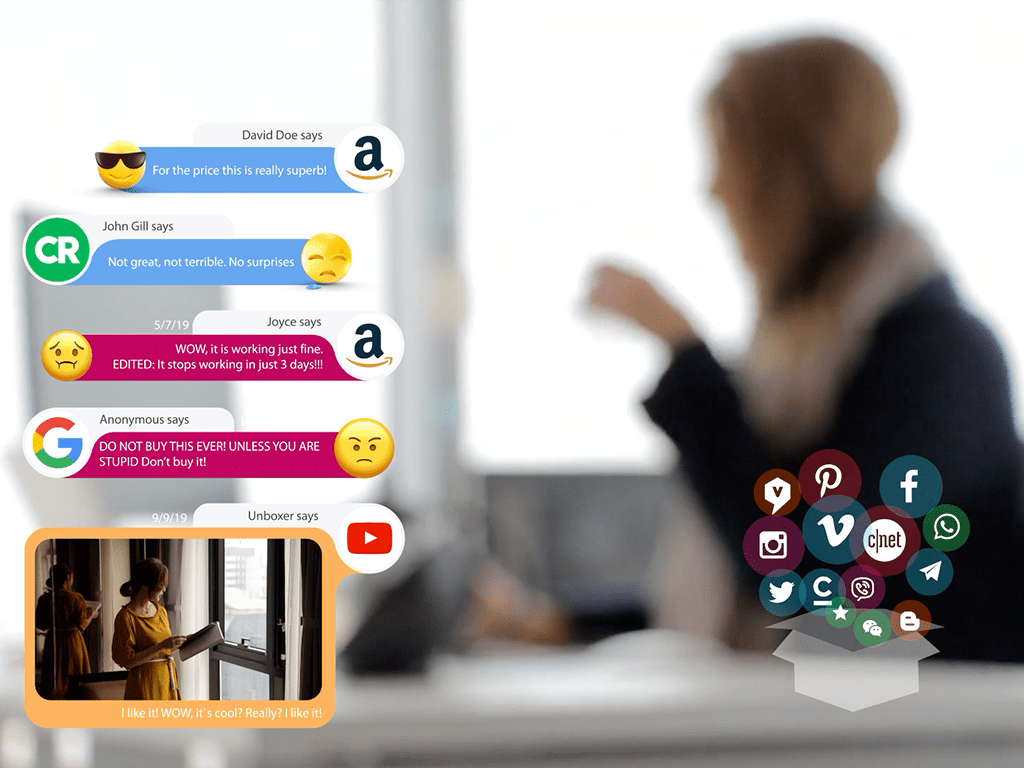Autore: Victor
Twissic: feedback pipeline as marketing and product strategy
Product lines
+300%
Instagram UGC Content
+546%
INDUSTRY
Accessories, Fashion, Watches PLATFORM Shopify, Indiegogo and Kickstarter CHALLENGE
Setting up post-purchase pipeline to upsell customers with add-ons, scale customer base with advocacy marketing and remarket to referral visits. SOLUTION
Offer warranty program as reward in return for customer feedback on extended value proposition and user advocacy through UGC
Sales may be a destination for your sales pipeline. But in this highly competitive market, it is just the beginning. The beginning for the next order if your brand decide to win customers’ hearts. Reallyview Reward Program is implemented by Twissic to collect feedback and user generated content, UGC. A warranty program is offered to customers through QR code for surveying upselling ideas. Customers happy with their experience were encouraged to share experience on Instagram.
Background: Kickstarter funded London Watch Brand Twissic is a London based premium watch company launched through Kickstarter in 2018. They are a team of experienced artisans in accessories and fashion putting together decades of experience in the industry. The Twissic brand makes best quality watches accessible through a Direct to Consumer, DTC, business model. That’s is why they have pin pointed their marketing focus on social and viral marketing which has scored them success in their crowdfunding campaigns. In the post Kickstarter world, Twissic keeps looking for ways to extend their success using the same success factor on alternative platforms. Reallyview provides them with the technical possibility to build a scalable advocacy and feedback pipeline for their operations. The Results: Identified new market and increased UGC on Instagram Why such a big change? We find 68% of consumers will leave a review if asked. Sometimes all it takes is to take your step. Check out other case studies for more successful stories here.
Twissic uses feedback for new marketing and product


Consumers now trust reviews more than ads
Consumers now trust reviews more than ads
With Reallyview, every one of your customers are brand advocates. They will leave reviews for you, usher in more customers and yield a higher ROI.
Explore our advocacy marketing demos today to stay ahead.
More is also available on our Youtube channel
Why it is important to have great online reviews?
Why it is important to have great online reviews?

Thanks to the internet, customers changed their ways of make purchasing decisions. Some years back, consumers rely on the in-your-face, one-way marketing messages for information about a brand. Today, consumers view these brand-crafted contents with suspicion. More and more consumers are turning towards Google, Yelp and other review sites as unbiased references. Reputation management is the cornerstone to the success of every single sale companies make.
Without a doubt, getting existing customers to review your products or services offers so many benefits. That is why advocacy marketing and reputation management should be your top priorities.
By the Numbers: The Power of Online Reviews
- 88% of people read online reviews of businesses before visiting them.
- A single bad online review can make you lose 30 customers.
- 68% of millennials place more trust in online reviews as against 34% who trust online adverts.
- Consumers are likely to spend 31% more on businesses that have great reviews.
- 72% of customers say they trust a business more because of its positive reviews.
- Four or more negative reviews about your services or products might make you lose 70% of your potential customers.
What Positive Online Reviews Could Mean for Your Business
More Sales
Sales rely on reputation management, advocacy marketing and positive reviews to your business. Customers find validation online before making the decision to purchase from the business. With great reviews of your business online, prospective customers are more likely to buy.
Higher Website Ranking
Every business aims to have strong online visibility. If you are struggling and failing to get your website seen on the internet, you should consider having great online reviews. Popular search engines, including Google, have algorithms that identify websites with excellent reviews. With positives reviews, search engines register brand quality and customer satisfaction. Thus, apart from implementing SEO practices, advocacy marketing is one of the sure-fire ways to get a high website ranking.
Increased Conversion Rate
Positive online reviews are similar to word of mouth. Most consumers are influenced to patronise your business by reviews of previous customers. Thus it crucial to ensure that customers do not just have excellent experiences, but also leave 5-stars ratings. The more positive reviews you have, the more convinced consumers are to use your services and buy your products. Therefore, having positive reviews increases your conversion rate and boosts sales and revenue.
Improved Reputation and Brand Visibility
Although a well-planned marketing campaign can gain new brand loyalist, it isn’t as effective as advocacy marketing. Today, consumers have more trust in the opinion of others than paid campaigns. According to 2015 report by Nielsen, 83% of consumers trusted the recommendations of family and friends.
Great online reviews help you build a trusted brand with a solid reputation on quality and customer satisfaction. So while you are stepping up your marketing efforts, you should also work to get great online reviews.
High Keyword
One of the ways positive online reviews help your business succeed is through the keywords included by customers. These keywords are seen by search engines and improve ranking on product searches.
Better Customer Engagement
Many times, customers who left reviews come back to see comments on their reviews. Other times, customers revisit the site for other peoples’ feedbacks. This creates an online social community that drives engagement and attachment to your brand.
Getting Your Business Really Viewed
That positive online reviews are the modern-day word of mouth is without question. But how do you get excellent reviews without the negative ones? So how do you turn a bad review experience into gaining a brand loyalist? It’s simple – Reallyview.
Reallyview is the go-to innovative advocacy and reputation marketing tool. It automates the feedback collection, analysis and response process using AI. It helps you understand customers’ preferences and how they feel.
With Reallyview, every one of your customers become brand advocates. They would generate more positive reviews, usher in customers and yield higher ROI.
Explore our advocacy marketing demos today to stay ahead.
How to calculate your product NPS?
How to calculate your product NPS?

NPS is the short form for Net Promoter Score. The Net Promoter Score is the measurement of customer experience, loyalty and satisfaction. It depends on how likely customers are to recommend the product or service to others on a scale of 0-10. Using the NPS formula to calculate customer’s satisfaction is important, as it helps build a base for NPS customer care.
The Net Promoter Score (NPS) is a customer loyalty score; it ranges from -100 to 100 and is calculated by asking customers one important question. The question is “what is the likelihood of you recommending our product/service/company to a friend or colleague, on a scale of 1-10?” NPS is a good business metric that helps businesses gather data on how well they are doing and the perception they have created for themselves.
It helps companies of all shapes and sizes to develop a mission-critical goal by getting feedback from customers and try to increase their NPS score by earning more satisfied and enthusiastic customers that can easily be tracked and quantified over time.
NPS was first developed in 2003 by Bain and Company, and it is now used by millions of companies and businesses in the world to measure and track how they are perceived by their customers. NPS has been held up as the number one standard for customer experience metric.
The Importance of NPS
NPS is important for companies and businesses, as it is a strong predictor the growth of a business. When a company measures its NPS and gets a high result, most times higher than the industry average, it shows that the company has an excellent relationship with its customers. These customers are likely to act as a publicist for the brand through word of mouth and help generate a positive growth cycle.
Although NPS is a valuable metric on a strategic level, on its own the score is not enough to paint a complete picture. However, why it is very useful and important is because it allows companies to ask follow-up questions as to why the customers gave a specific score; also it can help business to track and quantify a score over time, creating internal benchmarks along the way. Lastly, it can help rally all employees on the critical mission of earning more enthusiastic customers.
How to calculate NPS
It is quite easy to calculate your final NPS score. It is calculated by subtracting the percentage of customers who’s answers to the NPS question are with 6 or lower (the detractors) from the percentage of customers who’s answers to the NPS question are with a 9 or 10 (the promoters).
NPS formula = % promoters – % detractors
In the NPS system, customers fall into three groups, which are the promoters, the detractors, and the passives depending on how they answer the question asked.
Promoters – are the customers that give a 9 or 10, they represent the business’s most enthusiastic customers. They are the set of customers that are likely to increase referral flows, enhance a company’s reputation, and act as brand ambassadors that contribute to the growth of the company.
Detractors – are the customers that give a score of 0 to 6. They are unlikely to bring referrals, rather are they likely to recommend the company or product to others. They are not likely to patronize the business in a repeat purchase, and will likely discourage potential customers from patronizing.
Passives – they are customers that give a score of 7 or 8. They are in between, as they are unlikely to a brand through word of mouth, but will not actively recommend it to others. They are not included in the NPS calculation. However, they are usually close to being promoters, especially when they give a score of 8. So, companies usually spend time to investigate what to do to win them over completely.
Interpretation of NPS score
As stated earlier, the NPS score is always expressed as numbers between – 100 to 100. For the numbers to be negative the company will have more detractors than promoters, and for it to be positive, it is vice versa.
Knowing the NPS averages for industries is important, as it varies with each industry. The NPS average of your industry will help you understand how key competitors in your industry are faring. It helps set the context of how well or bad your company/business NPS score has gotten.
A good NPS score is any score from 0 above; as it indicates that the business has more promoters than detractors. Usually, top companies with the best NPS scores have 70 and above. A perfect score of 100 indicates that every customer that responded to the survey would recommend the company to someone else (something no company has ever achieved).
On the other hand, any score below 0 indicates a negative trend of having more detractors than promoters. However, here is where it is important to take note of industry benchmarks. If an industry NPS average is -6 and a company gets a -2, it suddenly looks not as bad as it seems.
However, it is not a good thing when the bar is too low. It shows that the entire industry has a lot of work to do to improve the situation. There should be more promoters than unhappy customers.
Ways to run NPS surveys and get feedback
- Email survey: You can collect NPS by emailing customers and prompting to fill a survey after purchase or interaction.
- Website survey: website pop-up surveys help you capture customer feedback while they are still on your website. You can set up the survey on your main conversion pages working with your developers.
- Product survey: You can add a QR code to product packaging or a card with your product packages. The QR code brings customers to a reviews site.
Ways to read your NPS results
- Track performance over time: the real power of an NPS score is clear when you look into trends and notice fluctuations.
- By looking at segments: your NPS score may vary by age group, gender, spending level, etc. You can further break it down into segments a more in-depth view.
- Close the loop: by asking follow-up questions, it helps you understand of the context behind the scores you get. This enables you to focus more on areas to address.
NPS is useful in a lot of ways. To grow your business, you need promoters than detractors. They are the ones that can bring referrals that grow your customer base, and also come back as repeat customers. Follow-up questions are essential during survey as they help you tackle the real issues and improve on the areas you are lagging.
Explore our Reallyview NPS platform demo today to stay ahead.
